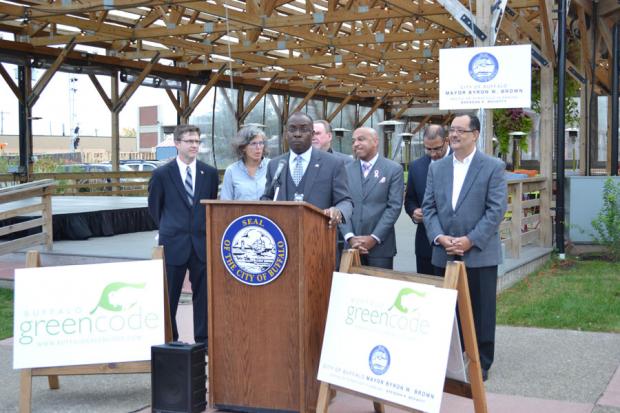The Green Code Is Here
After five years of meetings, sifting through mountains of input and many revisions the City of Buffalo has submitted the Buffalo Green Code to the city council.
The Green Code—also called the Unified Development Ordinance—is a complete overhaul of the city’s dated, confusing, and sometimes contradictory set of zoning and building codes, which dates back to the early 1950s. The unwieldy document currently in use—an 1,800 page amalgam—has often been the source of strife between neighbors and a constant headache for developers.
The document to be considered by the council is just 322 pages and its creators say it will promote urbanism in development, protecting the historic integrity of neighborhoods while also providing an easy to use and flexible template for developers and the various city departments and boards that deal with the code.
Mayor Byron Brown said the new code, if adopted, will accelerate the rate of development and redevelopment in the city, with builders spending less time and money getting through the onerous red tape currently in place.
“We are confident that once the review of the Green Code is completed and the Green Code is adopted that it will revolutionize the development process in the City of Buffalo,” Brown said.
The process, started in 2010, brought together partners like the University at Buffalo School of Architecture, consultants Code Studio, Camiros and Goody Clancy, thousands of citizens and members of the region’s development community.
After holding a series of community input meetings in schools and community centers throughout the city and gathering input from the business community the city and its partners used that information to compile a draft, which was then put out for public comment.
Now, five years later, the city’s common council will hold its own public input process before voting on the document’s adoption, a process that is expected to be complete by spring or early summer of 2016.
Brendan Mehaffy, the executive director of the city’s Office of Strategic Planning and the point man on the Green Code, was beaming at the afternoon press conference in Larkinville, an old industrial section of town that was largely abandoned five years ago and now is home to corporate offices, apartments, restaurants and breweries.
“The amount of effort that went into this was extraordinary,” Mehaffy said.
While the submission of the document represents a significant milestone, there is still much work to be done before the code is in place, Mehaffy said.
“This has been a long fight,” Mehaffy said. “We have, not necessarily, a fight, now ahead of us. It’s still a conversation to make sure that this is the best document to reflect what many of us know is one of the best cities in this country.”
This report appears courtesy of a content-sharing agreement with City & State.

